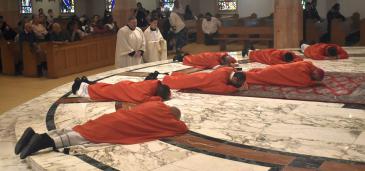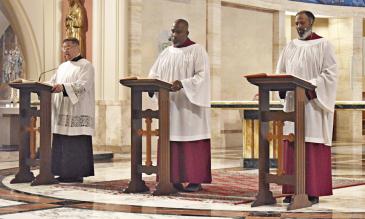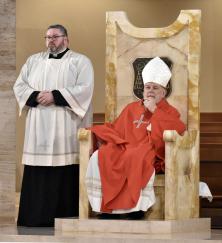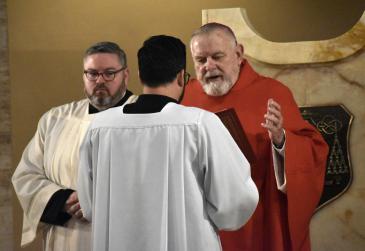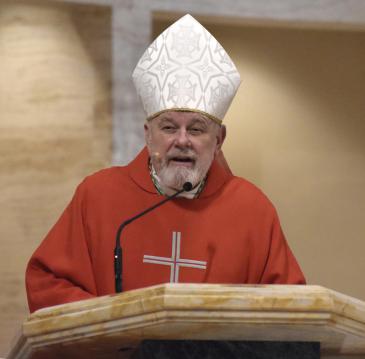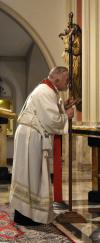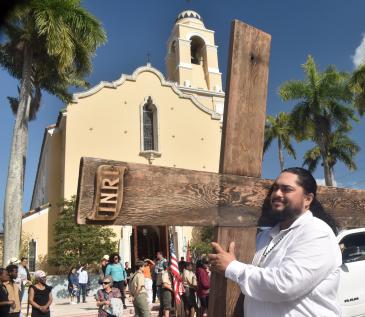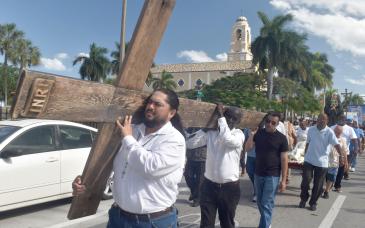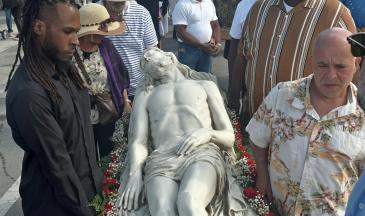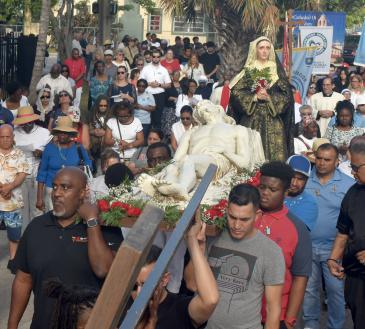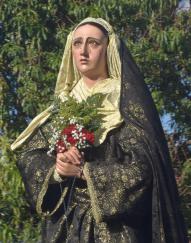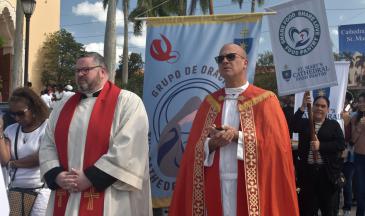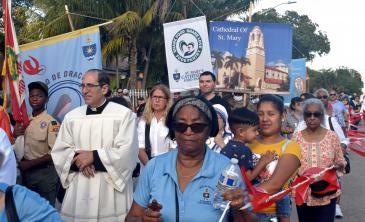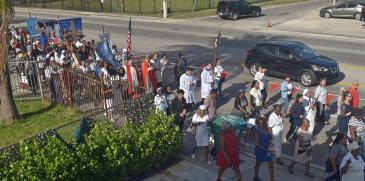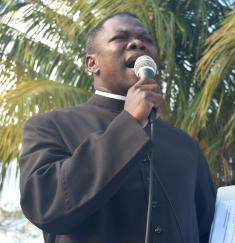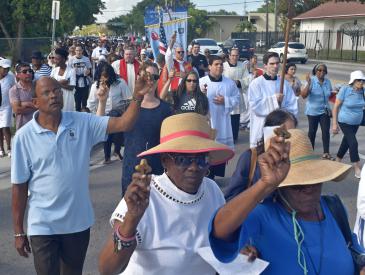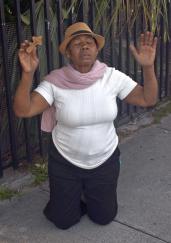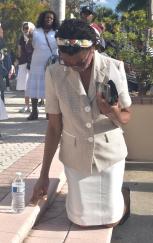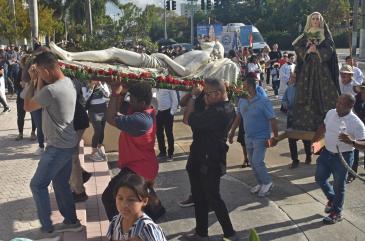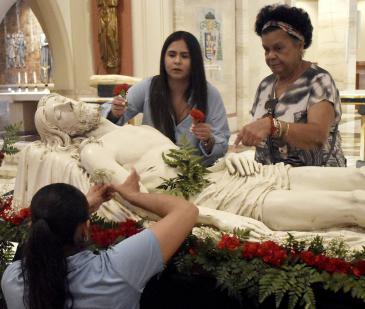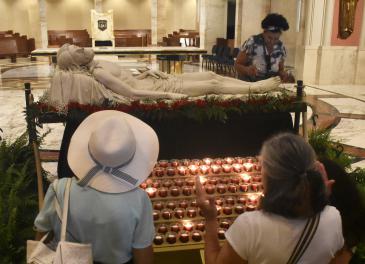By Archbishop Thomas Wenski - The Archdiocese of Miami
Photography: Jim Davis
Archbishop Thomas Wenski preached this homily during the Liturgy of the Lord’s Passion celebrated March 29, 2024 at St. Mary Cathedral.
In the prophet Isaiah’s account of the Suffering Servant, he says: “By his stripes, we were healed”.
Por sus llagas hemos sido sanados. ¿Debemos preguntarnos, si esto fue la cura, cual fue la enfermedad
Avèk tout kou li rezevwa yo, li ban nou gerizon. Fò n mande tèt nou, si sa se te gerizon an, ki sa maladi a te ye?
As we contemplate the image of Jesus, beaten, tortured, and dying on the cross –– we must ask ourselves: If this was the cure, ¿then what was the disease?
“By his stripes, we are healed.” What was in essence that disease that required so drastic a cure? I am sure that most of you have heard of the disease called arteriosclerosis – hardening of the arteries. Perhaps we could call the disease from which we suffered, and for which Jesus suffered and died to save us, cardiosclerosis –hardening of the heart. Scriptures do not use this word, of course, but we find its equivalents in scripture: Ezekiel talks of “hearts of stone,” Jeremiah speaks of the “uncircumcised heart,” and Moses in the Book of Deuteronomy just calls it “stubbornness of heart.”
Cardiosclerosis, we could say, is a genetic disease. We inherited it from our first parents, Adam and Eve. They said “no” to God and his will. That original sin represented a turning away from God, a shutting out of God, from the heart, by building stone walls of self-will. And while cardiosclerosis can be said to be in our genes, as it were, it is aggravated by our own lifestyle choices – the times when we have ratified that “no” with our own sins. And indeed, this is what hardness of heart represents in Scripture: the refusal to submit to God, to love him with one’s whole heart, to obey his law.
Sometimes, we build a stone wall around our hearts to keep God out. This certainly would describe the situation of those who have expelled God from their hearts by deadly sin, mortal sin. But it also can be true that we built a stone wall to keep God in – to contain him, to keep him in place. This I think applies to many of us who have accepted Christ, but our commitment is a bit lukewarm, and we like it just like that. We tacitly make God understand what he can and cannot ask of us. Prayer yes, but as long as we don’t lose our sleep; obedience yes, but don’t abuse our availability; chastity, yes, but not to the point of depriving us of those racy movies or T.V. shows we like. In other words, this too is cardiosclerosis – if not to bar God, to tame him.
Si arteriosclerosis endurece las arterias del cuerpo, podemos hablar de un cardio esclerosis que afecta el alma: el endurecimiento del corazón. Es una enfermedad genética. Nosotros la heredamos de nuestros primeros padres, Adán y Eva. Ellos dijeron "no" a Dios y su voluntad, pero nosotros también hemos agravado la situación con nuestros propios pecados. La dureza de corazón representa en la Escritura: la negativa a someterse a Dios, a amarlo con todo el corazón, a obedecer su ley. Jesús murió – para darnos un nuevo corazón. Ese corazón sólo puede ser nuestro a través de nuestra participación en su Pasión, muerte y resurrección, que da la vida nueva de la gracia, que es el fruto del Bautismo.
Jesus dies because of us but he also dies for us. He is truly man – his obedience makes up for the disobedience of our first parents: the Garden of Gethsemane redeems, as it were, the Garden of Eden. The human fear and treachery of Adam and Eve meet the human trust, love, and obedience of Jesus of Nazareth whom God calls his beloved one. From the Old Testament times, the People of God repeated the psalmist’s prayer: “Create in me, O God, a new heart.”
Jezi mouri akòz kè di nou an. Men, li mouri pou ban nou yon lòt kè Wi, kè nou te tounen di kou wòch akòz peche n yo; epi chak fwa nou di Bondye “non”, chak fwa nou refize viv dapre volonte li, kè nou vin pi di. Men, Jezi nan mouri li te mouri a, li di Bondye “wi”. Si nou te pèdi paradi akòz peche premye paran yo ak peche pa n yo, nou jwenn li ankò poutèt obeyizans Jezi. Kwa Jezi a se kle ki louvri ban nou pòt paradi yo. Jezi pran peche n yo sou do l epi li ban yon kè tou nèf, yon kè ki kapab renmen menm jan li renmen.
This is why Jesus died – to give us that new heart. That heart can only be ours through our sharing in His Passion, through our own dying and rising with him from sin to the new life of grace that is the fruit of Baptism. May his suffering, death and Resurrection give us new hearts and thus overcome the cardiosclerosis of our human condition. Then, the cross of Christ will no longer appear to us as “folly and scandal” but, on the contrary, as “strength of God and wisdom of God.” The cross becomes not an instrument of torture but a reason for our certainty, the supreme proof of the love of God for us. With the new heart formed within the pierced heart of Christ himself, we can say with St. Paul: “Far be it from me to glory except in the cross of our Lord Jesus Christ.”
We adore thee, O Christ, and we praise Thee, because by Thy holy Cross thou hast redeemed the world!

